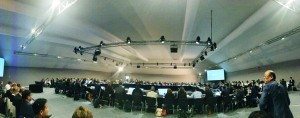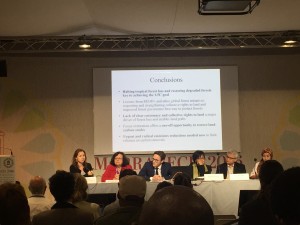By Sara Velander, Jenna Farineau, and Elaina Burress.
After the final text of the Paris Agreement was adopted mid-December 2015, several land-focused organizations analyzed the different ways land use and agriculture are positioned in the agreement, in order to identify the future trajectory of land use in international climate policy. According to Climate Focus, the Agreement made specific references to land use in various articles including Article 5 on forests, and a reference to food production in Article 2. However, these are merely recognizing land use in the agreement and have no binding provisions as of yet. Where land use is likely to have the biggest role is in the accounting of emissions and removals in Nationally Determined Contributions (NDCs), one of the few binding obligations of the Paris Agreement.
As we start yet another week of climate negotiations, we find ourselves reflecting on the first week of COP22: the only week land use was discussed under the Paris Agreement. Those of us interested in agriculture and forestry have been running back and forth between civil society meetings and negotiations, fighting for the few constituency tickets available for observer organizations to attend meetings under the Ad Hoc Working Group on the Paris Agreement (APA). We’ve been sitting through land-related side events, as well as participating in land-focused actions.
Yet at the few negotiations we were able to attend, we realized, to our disappointment and expectations, that nothing substantive on land use came out of the negotiations under the APA. It will instead be discussed in later meetings in 2017 and 2018. This COP has been purely procedural, leaving little room for elaborations on the actual content of the Paris Agreement as it pertains to agriculture, forests and other land uses. However, even if the outcomes for land use at COP22 were minimal (if not non-existent) we still gained significant insight on where land use appears in the Paris Agreement, how it will be discussed in future sessions, and the major arguments and demands requested by land-focused civil society organizations.
During week one of COP22, land use appeared under two subsidiary bodies to the UNFCCC: the Subsidiary Body on Scientific and Technological Advice (SBSTA) and the APA. These bodies had separate meetings called “informals” and “informal informals” according to the specific agenda items they had published on the UNFCCC website several weeks before negotiations started.

In SBSTA there were three agenda items on land use:
- Item 7: issues related to agriculture
- Item 11: (a) Land Use, Land-Use Change and Forestry (LULUCF) under the Kyoto Protocol and the Clean Development Mechanism (CDM); and (b) carbon dioxide capture and storage
- Item 12(c): work program under the framework for non-market approaches of the Paris Agreement
In the APA there were several agenda items that directly and indirectly alluded to land use:
- Item 3(c): accounting for parties’ nationally determined contributions
- Item 5: modalities, procedures and guidelines for the transparency framework for action and support
- Item 6: matters relating to the global stocktake.
The main land use item we followed was APA item 3(c), which was also the hot topic among land-focused civil society because of it’s impact on how parties under the Paris Agreement account for their emissions by sources (deforestation, agriculture) and removals by sinks (forests, agriculture) from the land sector in their NDCs. This is a crucial issue because if land emissions and removals are accounted under the same rules as other sectors (like the energy sector for example), it implies that sequestered carbon is permanent and has no leakage of emissions. However, there is scientific proof that these sinks are non-permanent and should therefore be accounted separately based on their limits to sequester carbon.
At COP22, civil society has demanded that emissions and removals be accounted for separately, and that sectors are differentiated. Civil society has also urged that NDCs be required to include information on how countries are able to ensure that the key principles and obligations in the Paris Agreement are protected. Lastly, civil society has stressed the need for transparency in the reporting of mitigation action in the land sector.
However, none of these demands were raised during the informal negotiations on item 3(c), as there was little discussion on the risks of accounting of the land sector in NDCs, or land use at all for that matter. Some interventions given by parties, including Norway and China, did reference land use, but overall, the discussions were centered on procedure, and views were expressed by countries on the use of differentiated accounting or common accounting for all countries in their NDCs. In conclusion, there will be a future round table discussion happening in Bonn on May 2017 during the resumed APA session, which will discuss the technical issues of NDCs, as well as features and accounting. It will be closed for observers, and will have no formal outcomes.
SBSTA met several times the first week of COP22 and much like what happened in the APA, nothing really substantive came out of the informal consultations or informal informals. Conclusions were mainly procedural, and lacked the substantial progress that many Parties had hoped for in discussions surrounding agriculture, food security, and land use. Parties had trouble reaching agreement as they stressed the urgency of moving forward in fear of spending too much time looking at specifics that would be impossible to reach full consensus on.
Specifically looking at agriculture, the conclusion put forth pushed discussions forward to May, when Parties will gather again for the intercessional in Bonn. During the meetings here at COP22, the EU expressed the ways in which agriculture and land might provide substitutes for fossil resources (aka biofuel development). The block G77+China, on the other hand, was more interested in switching the focus to finance and adaptation, not mitigation. Several other Parties were pushing for a work programme that would comprehensively address emissions and food security under SBSTA. However, this also was not achieved.
Land use negotiations under SBSTA ended about the same: with a proposed substantive non-paper by Colombia, that ultimately did not reach consensus due to several parties’ disagreements over what was proposed, varying in different aspects. Colombia presented their non-paper with the opinion that the draft conclusion (presented by the co-facilitators) lacked the substance needed to push discussions further. The non paper mentioned revegetation as a mitigation strategy, and ended with two phrases that would either conclude or continue this specific discussion on LULUCF.
Overall, Colombia stressed that if this substantive text were not a part of the conclusion at COP22, then future meetings not result in any further achieved outcomes. Many countries like Peru, Iraq, and Australia supported Colombia’s non paper, while other countries such as South Africa and Zimbabwe raised concerns about the language proposed in certain paragraphs, as well as the potential to conclude over continuing the discussions. The co-facilitator stepped in at this time to present two final options: to proceed with the procedural conclusion put forward by the co-facilitators, or to go into “a 10 minute huddle” to discuss Colombia’s non paper, as Switzerland had suggested. China began the long chain of Party agreements to go forward with the conclusion presented by the co-facilitators, and to scrap Colombia’s non paper.

Even though nothing came out of these negotiations, the fight is not over! If anything, the lack of progress on land use should incentivize civil society to work harder on pushing their demands onto the negotiation table. There is plenty of work to do here, whether it be at future intercessional meetings in Bonn, or the 2018 review of countries’ NDCs and long term strategies to Paris Agreement, also known as the Facilitative Dialogue 2018. Close attention must be put on how parties will ramp up their ambition before 2020, while making it very clear that 1.) markets need to be kept out of the land sector, 2.) that so-called “innovative” carbon-capture and storage technologies are not the solution, and 3.) that accounting of emissions and removals from the land sector need to be separate and transparent, incorporating the inherent limits of mitigation in the land sector. For these demands to be heard, it is necessary to continue this work internationally and domestically, not waiting for the infrequency and idleness of Parties’ ambitions.

Thank you for the thorough update! If pre-2020 ambition keeps being so absent and as time passes, i wonder if land-use mitigation mechanisms are going to become the last card to be pulled by developed countries to say they are doing something…..
And are discussions on REDD+ delayed until COP23? Forgot how it ended in Paris…